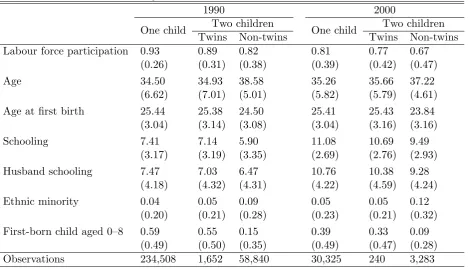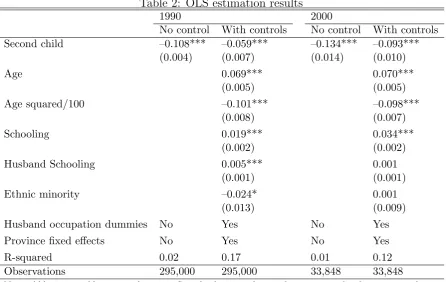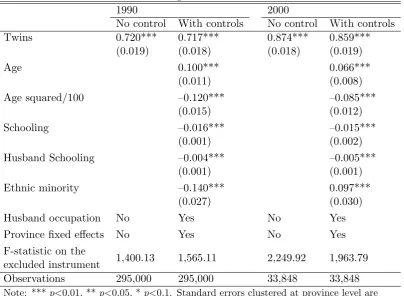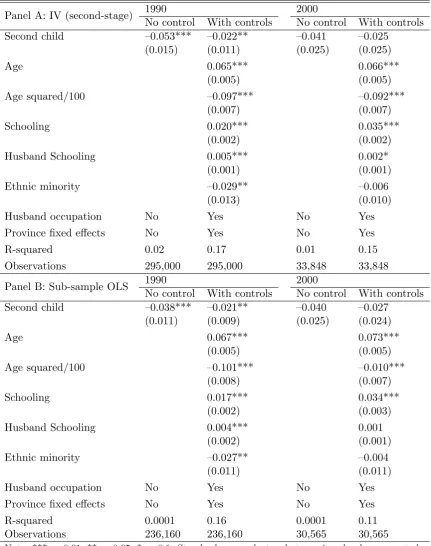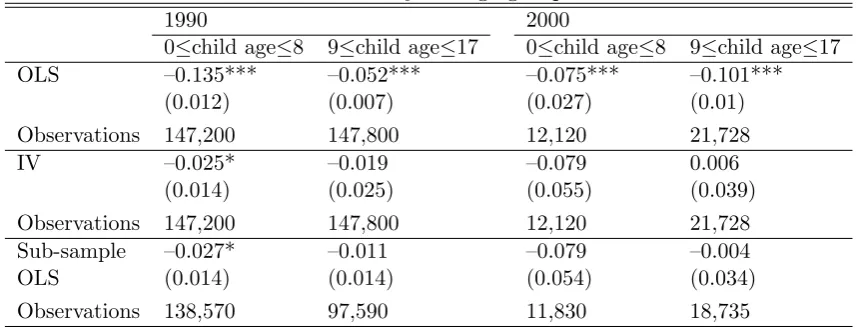Munich Personal RePEc Archive
Fertility and Female Labour Force
Participation: Causal Evidence from
Urban China
He, Xiaobo and Zhu, Rong
July 2015
Online at
https://mpra.ub.uni-muenchen.de/65650/
Fertility and Female Labour Force Participation:
Causal Evidence from Urban China
∗
Xiaobo He
†, and Rong Zhu
‡Abstract
Using population census data, this paper examines the causal effect of a second
child on married women’s labour force participation in urban China. To ameliorate
the endogeneity of fertility, we exploiting twin births as the source of variation in
fer-tility. While the ordinary least squares estimates indicate that having one more child
significantly reduces female labour force participation by around 6 and 9 percentage
points in 1990 and 2000 respectively, our causal analyses suggest very small negative
effect in 1990 (around 2 percentage points) and insignificant effect in 2000.
J EL classif ication: J13; J21
Keywords: Female labour force participation, Fertility, One-Child Policy
∗We are grateful to the Editors of the journal, Chris Orme and Martyn Andrews, for helpful comments.
Thanks also go to two anonymous referees, Tatyana Chesnokova, Elisabetta Magnani, Nicholas Sim, Le Wang and seminar participants at the University of Adelaide for useful suggestions. The usual disclaimer applies.
†School of International Economics and Trade, Shanghai Finance University, China; and Global Food
Studies, Faculty of the Professions, University of Adelaide. E-mail Address: xiaobo.he@adelaide.edu.au.
‡Corresponding author. National Institute of Labour Studies, Flinders University, Australia. E-mail
1
Introduction
From the late 1980s, the growth rate of Chinese population began to fall in the wake of
the One-Child Policy initiated in 1979. It is believed that one of the Chinese panaceas of
long-lasting rapid economic growth is the population control policy which has successfully
maintained a low total dependency ratio in the last three decades (Wei and Hao, 2010).
While China’s great achievement is admirable, China is recently facing an unprecedented
challenge of population ageing. A shrinking young cohort due to tight fertility control
post 1979 contributed to a lower total dependency ratio that benefited China’s economic
growth in the past thirty years. However, the low fertility rate along with the improvement
of Chinese life expectancy leads to the current ageing dilemma. Precisely, elder people aged
above 65 accounted for 8.87% of total population in 2010 while the figure was 6.96% in 2000
(National Bureau of Statistics China, 2011). The demographic transition with more elder
dependents but less prime-age labourers leads to potential labour shortages and growing
pressure on China’s sustainable development. On December 28th of 2013, the Standing
Committee of the National People’s Congress of China passed a resolution on relaxing the
One-Child Policy and allowing couples to have a second baby if either parent is an only
child. A key policy concern is that whether more children discourages female labour force
participation.
Though the question is important, the answer is not yet clear-cut as the relationship
between the number of children and mother’s work is confounded by endogenous fertility
decisions. Ignoring individual unobserved heterogeneity such as preferences for childbearing
and career ambition, ordinary least squares (OLS) regressions may overestimate the impact
of fertility on female labour force participation (Ag¨uero and Marks, 2008). In addition,
the effect running from female labour force participation to fertility decisions indicates the
presence of reverse causality (Mishra and Smyth, 2010).
This paper contributes to the debate on whether there is a causal link between female
labour supply and fertility (Bronars and Grogger, 1994; Angrist and Evans, 1998;
Jacob-1
sen et al., 1999; Chun and Oh, 2002; Cruces and Galiani, 2007; Ag¨uero and Marks, 2008;
Caceres-Delpiano, 2009), and also complements to the recent studies examining the
deter-minants of female participation in the labour force in China (Maurer-Fazio et al., 2011;
Liu, 2012). Exploiting twin births as the source of exogenous variation in family size, we
investigate the causal effect of having a second child on female labour force participation
in urban China. While the ordinary least squares estimates indicate that having one more
child reduces female labour force participation by 6 and 9 percentage points in 1990 and
2000 respectively, our causal analyses suggest very small negative effect in 1990 (around 2
percentage points) and insignificant effect in 2000.
The remainder of the paper is organized as follows. Section 2 is a description of the
data sets. The following section presents the empirical approach taken. In Section 4, we
present and discuss the regression results. Section 5 concludes.
2
Data
We use the 1% sample of the 1990 Chinese Population Census and the 0.095% sample of the
2000 Chinese Population Census for this analysis. The data sets contain the information for
all residents in each sampled household. Children and their parents are matched according
to the within-household relation identifier in the data. Following Li et al. (2008), twins
are defined as children born in the same year and month by the same mother.
To facilitate the analysis, we apply a few sample restrictions. First, we only focus on
women in urban China as female labour force participation in rural areas can be quite
different (Barrett et al., 1991). Second, only married mothers aged between 20 and 50,
whose co-residency children are 17 or younger and whose husbands living in the same
households, are used. Third, we only include the mothers with one or two children in the
final sample, not only because having three or more children in a family is rare in urban
China nowadays, but also because we are specifically interested in examining the potential
effect of relaxing the One-Child Policy on female labour force participation.
2
Table 1: Summary statistics for married women in urban China
1990 2000
One child Two children One child Two children Twins Non-twins Twins Non-twins Labour force participation 0.93 0.89 0.82 0.81 0.77 0.67
(0.26) (0.31) (0.38) (0.39) (0.42) (0.47) Age 34.50 34.93 38.58 35.26 35.66 37.22
(6.62) (7.01) (5.01) (5.82) (5.79) (4.61) Age at first birth 25.44 25.38 24.50 25.41 25.43 23.84
(3.04) (3.14) (3.08) (3.04) (3.16) (3.16) Schooling 7.41 7.14 5.90 11.08 10.69 9.49
(3.17) (3.19) (3.35) (2.69) (2.76) (2.93) Husband schooling 7.47 7.03 6.47 10.76 10.38 9.28
(4.18) (4.32) (4.31) (4.22) (4.59) (4.24) Ethnic minority 0.04 0.05 0.09 0.05 0.05 0.12
(0.20) (0.21) (0.28) (0.23) (0.21) (0.32) First-born child aged 0–8 0.59 0.55 0.15 0.39 0.33 0.09
(0.49) (0.50) (0.35) (0.49) (0.47) (0.28) Observations 234,508 1,652 58,840 30,325 240 3,283
N ote: Standard deviations are reported in parenthesis.
A mother is considered as a labour force participant if she is either employed or is
actively looking for a job. Those who are not employed and no longer actively searching
for work are considered to be out of labour force. Table 1 displays the summary statistics.
Female labour force participation rates are found to be declining over time in urban China,
consistent with the findings in Maurer-Fazio et al. (2011) and Liu (2012). The statistics
also show that mothers giving birth to singletons and mothers giving birth to twins have
similar individual characteristics in both 1990 and 2000.
3
Empirical strategies
We use two identification strategies to explore the causal link between fertility and female
labour force participation in China.
3.1
IV approach
The first strategy employed is an instrumental variable (IV) approach. Following existing
studies such as Ag¨uero and Marks (2008), we use the following linear specification
LF Pi =c1+αChildreni+γ′Xi+ui (1)
Childreni =c2+βT winsi+δ′Xi+vi (2)
where the dependent variable LF Pi is equal to one if a woman is in the labour force, and
zero otherwise. The endogenous explanatory variable Childrenis the number of children
in each household (either one or two). The parameter α indicates the effect of having one
more child on women’s labour force participation. Xi is a vector of control variables
includ-ing mother’s age, age squared, mother’s years of schoolinclud-ing, ethnicity dummy, husband’s
years of schooling and their occupation dummies as well as province fixed effects. c1 and
c2 are constants. ui and vi denote error terms.
Wife’s education and her husband’s education are used as exogenous controls in our
estimation as most people in China usually complete their formal education before giving
birth to children. The data do not have the information on husbands’ income, which is
highly likely to affect marred women’s participation decisions. We use husbands’s years of
schooling and occupation information (seven occupation dummies) as the proxy variables
for husband’s income. The inclusion of these controls in the regressions can also increase
the precision of our estimates.
The ordinary least squares (OLS) estimation of equation (1) will inconsistently estimate
the coefficient of α because of the endogeneity of fertility decisions resulting from
unob-served heterogeneity and reverse causality. We exploit a binary variable T winsi, which is
equal to one if a woman is a mother of twins and zero otherwise, as the instrumental
vari-able forChildreniin equation (2) (Angrist and Evans, 1998; Jacobsenet al., 1999). The IV
estimate of αcan consistently measure the effect of an additional child on women’s labour
3
force participation. This identification strategy relies on, first, the exogenous variation
of family size that a twins shock generates; second, the exclusion restriction that having
twins is not associated with female labour force participation decisions unless through the
channel of family size; and last, the monotonicity assumption that the effect of twin births
on the number of children in a family is always positive.
3.2
Sub-sample OLS estimation
Our second identification strategy employs ordinary least squares (OLS) estimation but
using a sub-sample of our data. Same as Equation (1), the model is specified as
LF Pi =c1+αChildreni+γ′Xi+ui (3)
We conduct the estimation using the sample composed of (i) women with one child only
and (ii) women with twins. We exclude from the estimation women with two children who
are not twins. The final sub-samples utilised consist of 236,160 women (234,508 mothers
with one child and 1,652 mothers with twins) in 1990 and 30,565 women (30,325 mothers
with one child and 240 mothers with twins) in 2000.
In this model, no instrument is needed as the variation in the number of children
only comes from having twins, which can be considered as exogenous. This approach will
estimate the effect of moving from one to two children, a very relevant estimate that can
be applied to many Chinese women now that the One-Child Policy has been relaxed since
December 2013.
3.3
Possible threat to identification
The identification strategies described in Sections 3.1 and 3.2 rely on the randomisation
nature of twin births. Many existing studies have utilised multiple births as the source
of exogenous variation in family size to examine the effect of fertility on mothers’ labour
market outcomes (Bronars and Grogger, 1994; Angrist and Evans, 1998; Jacobsen et al.,
4
We thank one anonymous referee for this suggestion.
5
1999; Caceres-Delpiano, 2009). Other studies have investigated the quality-quantity
trade-off among children (Li et al., 2008; Liu, 2014) and the effects of child-bearing on women’s
marital status (Jacobsen et al., 2001). This study has followed the aforementioned studies
in exploiting multiple births as the source of variation in family size.
Although widely used in the existing literature, twin births may not be completely
random. For example, multiple births are common among mothers undergoing fertility
treatments. As twining is allowed under the One-Child Policy, some families may have used
fertility treatments in a deliberate attempt to bear more babies, and at the same time, to
get around the One-Child policy. Without sufficient information in the data, we cannot
rule out this possibility. If some mothers of twins have chosen to use fertility treatments,
they can be different in unobservables from mothers of singletons. For example, women
who take fertility drugs usually have the preference to larger families and less attachment
to labour force. In this case, we may overestimate the magnitude of the potential negative
impact of fertility on women’s labour force participation, using the identification strategies
described in Sections 3.1 and 3.2.
4
Results
Table 2 shows the ordinary least squares (OLS) regression results. Without using any
controls, women having two children are respectively 10.8 and 13.4 percentage points less
likely to be in the labour force than those with one child in 1990 and 2000. The inclusion
of control variables in the estimation reduces the magnitudes of the associations between
fertility and female labour force participation to 5.9 and 9.3 percentage points in 1990
and 2000 respectively. This is consistent with the well-established negative correlation
between fertility and mother’s work in the existing literature for both developed countries
6
Interested readers are referred to the following BBC news (13 February 2006): “Fertility drug use booms in China” (http://news.bbc.co.uk/2/hi/asia-pacific/4708432.stm).
7
(Angrist and Evans, 1998; Jacobsen et al., 1999) and developing economies (Cruces and
Galiani, 2007; Ag¨uero and Marks, 2008). However, one should interpret this correlation
with caution as ignoring the endogeneity of fertility in women’s work decisions is likely to
[image:9.595.80.527.169.451.2]result in inconsistent estimates.
Table 2: OLS estimation results
1990 2000
No control With controls No control With controls Second child –0.108*** –0.059*** –0.134*** –0.093***
(0.004) (0.007) (0.014) (0.010)
Age 0.069*** 0.070***
(0.005) (0.005)
Age squared/100 –0.101*** –0.098***
(0.008) (0.007)
Schooling 0.019*** 0.034***
(0.002) (0.002)
Husband Schooling 0.005*** 0.001
(0.001) (0.001)
Ethnic minority –0.024* 0.001
(0.013) (0.009)
Husband occupation dummies No Yes No Yes Province fixed effects No Yes No Yes
R-squared 0.02 0.17 0.01 0.12
Observations 295,000 295,000 33,848 33,848
Note: ***p<0.01, **p<0.05, *p<0.1. Standard errors clustered at province level are reported in parentheses.
We report the first-stage results of instrumental variable (IV) regressions in Table 3.
The presence of twin births is used as the instrumental variable for the number of children
(either 1 or 2) in a family. The first-stage results all show that the instrument T wins is
significantly correlated with the number of children a woman has in both 1990 and 2000.
The F-statistics on the excluded instrument in the first stage regressions far exceed the
Staiger and Stock (1997) rule-of-thumb threshold of 10. This indicates that the instrument
is not weak and has sufficient power in our specifications.
The second-stage results of IV regressions reported in Table 4 show that having two
children has a very small but statistically significant effect on female labour force
partic-ipation in 1990. More specifically, having two children will lead to a decrease of female
Table 3: First-stage results of IV estimation
1990 2000
No control With controls No control With controls Twins 0.720*** 0.717*** 0.874*** 0.859***
(0.019) (0.018) (0.018) (0.019)
Age 0.100*** 0.066***
(0.011) (0.008)
Age squared/100 –0.120*** –0.085***
(0.015) (0.012)
Schooling –0.016*** –0.015***
(0.001) (0.002)
Husband Schooling –0.004*** –0.005***
(0.001) (0.001)
Ethnic minority –0.140*** 0.097***
(0.027) (0.030)
Husband occupation No Yes No Yes Province fixed effects No Yes No Yes F-statistic on the
1,400.13 1,565.11 2,249.92 1,963.79 excluded instrument
Observations 295,000 295,000 33,848 33,848
Note: ***p<0.01, **p<0.05, * p<0.1. Standard errors clustered at province level are reported in parentheses.
participation rate is causally affected by having a second child in 2000. One possible reason
for the insignificant effect in 2000 is that the much smaller sample size in 2000 produces
estimates with less precision, although the IV estimates share similar magnitude in 1990
and 2000. To sum up, we find that having two children in China is unlikely to
substan-tially reduce the female labour force participation rate in urban China. Clearly, the OLS
estimates overstate the impact of fertility on labour force participation of women in urban
China.
Table 4 also reports the sub-sample OLS estimates when this alternative identification
strategy is used. We include women with one child and women with two children who are
twins in the estimation. Women with two children who are not twins are excluded. In
the context of the One-Child policy, this identification comes from the fact that among
this sub-sample of women who comply with the policy, one can have more than one child
only if she has twins at first birth, which is largely random with respect to labour force
8
Table 4: IV and sub-sample OLS estimation results
Panel A: IV (second-stage) 1990 2000
No control With controls No control With controls Second child –0.053*** –0.022** –0.041 –0.025
(0.015) (0.011) (0.025) (0.025)
Age 0.065*** 0.066***
(0.005) (0.005)
Age squared/100 –0.097*** –0.092***
(0.007) (0.007)
Schooling 0.020*** 0.035***
(0.002) (0.002)
Husband Schooling 0.005*** 0.002*
(0.001) (0.001)
Ethnic minority –0.029** –0.006
(0.013) (0.010)
Husband occupation No Yes No Yes
Province fixed effects No Yes No Yes
R-squared 0.02 0.17 0.01 0.15
Observations 295,000 295,000 33,848 33,848
Panel B: Sub-sample OLS 1990 2000
No control With controls No control With controls Second child –0.038*** –0.021** –0.040 –0.027
(0.011) (0.009) (0.025) (0.024)
Age 0.067*** 0.073***
(0.005) (0.005)
Age squared/100 –0.101*** –0.010***
(0.008) (0.007)
Schooling 0.017*** 0.034***
(0.002) (0.003)
Husband Schooling 0.004*** 0.001
(0.002) (0.001)
Ethnic minority –0.027** –0.004
(0.011) (0.011)
Husband occupation No Yes No Yes
Province fixed effects No Yes No Yes R-squared 0.0001 0.16 0.0001 0.11 Observations 236,160 236,160 30,565 30,565
participation. Applying OLS estimation to this sub-sample, the effect estimated can be
interpreted as the causal effect of moving from one to two children if twin births are random.
Results reported in Table 4 are very similar to those obtained using IV estimation, in terms
of both magnitude and precision.
One particular pattern of results reported in Table 4 deserves special attention. If twin
births are completely random, controlling for and not controlling for covariates should
pro-duce point estimates of virtually identical magnitude. However, the estimated coefficients
of second child reported in Table 4 are larger when not controlling for covariates than when
controlling for covariates, indicating twin births are not a completely random event. Some
twin births may be from mothers undergoing fertility treatments and the selection into
fertility treatments is not random. As women who take fertility drugs usually prefer larger
families and less attachment to labour force, results reported in Table 4 may have
over-stated the magnitude of the negative estimates, which further strengthens our conclusion
that having a second child can hardly constitutes a great barrier to women’s labour force
participation in urban China.
The above analyses consider the effect of a second children aged 0–17 on mothers’
labour force participation. A natural question to ask is whether children belonging to
different age groups have differential effects on mothers’ participation in the workforce.
For example, mothers of younger children may need to provide more childcare and other
non-market services; consequently, they can be more likely to drop out of the labour force
entirely. In contrast, school-aged children may not affect their mother’s current labour
force participation as much since they need less care than younger children do.
Table 5 shows the estimation results for two groups of mothers defined by the age of
their first born children (0–8 and 9–17). We pay particular attention to the IV and
sub-sample OLS estimates, after controlling for observed characteristics. We find that in the
1990 sample, having an additional child aged 8 or below will lead to a decrease of women’s
labour force participation rate by about 2.5–2.7 percentage points. However, school aged
children are not found to significantly affect mothers’ labour force participation. The IV
Table 5: Estimation results by the age group of first-born child
1990 2000
0≤child age≤8 9≤child age≤17 0≤child age≤8 9≤child age≤17 OLS –0.135*** –0.052*** –0.075*** –0.101***
(0.012) (0.007) (0.027) (0.01) Observations 147,200 147,800 12,120 21,728
IV –0.025* –0.019 –0.079 0.006
(0.014) (0.025) (0.055) (0.039) Observations 147,200 147,800 12,120 21,728 Sub-sample –0.027* –0.011 –0.079 –0.004 OLS (0.014) (0.014) (0.054) (0.034) Observations 138,570 97,590 11,830 18,735
Note: ***p<0.01, **p<0.05, * p<0.1. Control variables include mother’s age, age squared, mother’s years of schooling, ethnicity dummy, husband’s years of schooling, husband’s occupation and province dummies. Standard errors clustered at province level are reported in parenthesis.
evidence that a second child will not affect women’s work decisions in 2000, regardless of
child age.
Linking our findings to China’s fertility control policies, we argue that the potential
negative influence of bearing a second child on female labour force participation would
be either insignificant or very small after the recent relaxation of the One-Child Policy.
Given the small or insignificant effects reported in Tables 3, 4 and 5 and the extremity of
having two children simultaneously, the actual impact of a second child on mother’s work
decision could be negligible. Unlike a mother with twin children who is more likely to quit
the labour market as more time is needed for childcare, a women giving a non-twin birth
may smooth the second-child shock by rationally lengthening the birth spacing. Thus, our
estimates actually constitute the upper bound of the effect of fertility on female labour
force participation, which strengthens the main conclusion of this study.
5
Conclusion
This paper investigates the relationship between fertility and female labour force
partic-ipation in urban China. By exploiting twin births as the source of exogenous variation
in the number of children, our analyses show that having a second child can hardly
One-Child Policy is unlikely to affect substantially the female labour force participation in
urban China.
References
Ag¨uero, J., and Marks, M., 2008. Motherhood and female labor force participation: Ev-idence from infertility shocks. American Economic Review, Papers & Proceedings, 98, 500–504.
Angrist, J., and Evans, W., 1998. Children and their parents’ labor supply: Evidence from exogenous variation in family size. American Economic Review,88, 450–477.
Angrist, J., and J.-S. Pischke (2009). Mostly Harmless Econometrics: An Empiricist’s Companion. Princeton University Press.
Barrett , R., Bridges, W., Semyonov, M., and Gao, X., 1991. Female labor force partici-pation in urban and rural China. Rural Sociology, 56, 1–21.
Bronars, S., and Grogger, J., 1994. The economic consequences of unwed motherhood: Using twin births as a natural experiment. American Economic Review 84, 1141–56.
Caceres-Delpiano, Julio. 2008. Keeping the best for last: impact of fertility on mother’s employment: Evidence from developing countries. Economics Working Papers 08-68(32), Universidad Carlos III, Departamento de Economia.
Cai, Y., 2008. An assessment of China’s fertility level using the variable-r method. De-mography, 45, 271–281.
Chun, H., and Oh, J., 2002. An instrumental variable estimate of the effect of fertility on the labour force participation of married women. Applied Economics Letters, 9, 631–634.
Cruces, G., and Galiani, S., 2007. Fertility and female labor supply in Latin America: New casual evidence. Labour Economics, 17, 565–573.
Imbens, G., and J. Angrist (1994). Identification and estimation of local average treatment effects. Econometrica, 62, 467–475.
Jacobsen, J., Pearce, J., and Rosenbloon, J. 1999. The effects of child-bearing on married women’s labor supply and earnings: Using twin births as a natural experiment. Journal of Human Resources, 34, 449–474.
Jacobsen, J., Pearce, J., and Rosenbloon, J. 2001. The effects of child-bearing on women’s marital status: Using twin births as a natural experiment. Economics Letters,70, 133–138.
value decomposition. Journal of Econometrics, 133, 97–126.
Li, H., Zhang, J., and Zhu, Y., 2008. The quantity-quality trade-off of children in a devel-oping country: Identification using Chinese twins. Demography,45, 271–281.
Liu, H., 2014. The quality-quantity trade-off: Evidence from the relaxation of China’s One-Child policy. Journal of Population Economics, 27, 565–602.
Liu, Q., 2012. Unemployment and labor force participation in urban China. China Eco-nomic Review, 23, 18–33.
Maurer-Fazio, M., Connelly, R., Chen, L., and Tang, L,. 2011. Childcare, eldercare, and labor force participation of married women in urban China, 1982–2000. Journal of Human Resources, 46, 261–294.
Mishra, V., and Smyth, R., 2010. Female labor force participation and total fertility rates in the OECD: New evidence from panel cointegration and Granger causality testing. Jour-nal of Economics and Business, 62, 48–64.
National Bureau of Statistics China, 2009. China Compendium of Statistics. China Statis-tics Press, Beijing.
National Bureau of Statistics China, 2011. The Sixth National Population Census Gazette (No.1).
Short, S.E., and Zhai, F., 1998. Looking locally at China’s One-Child policy. Studies in Family Planning, 29, 373–387.
Staiger, D., and Stock, J., 1997. Instrumental variables regression with weak instruments.
Econometrica, 65, 557–586.
